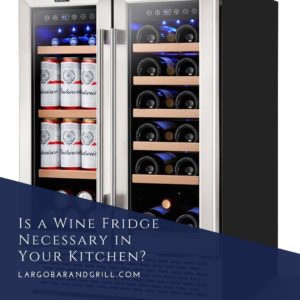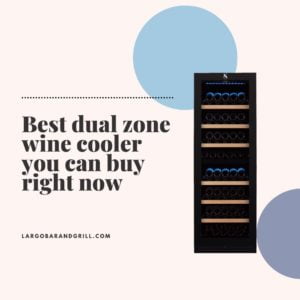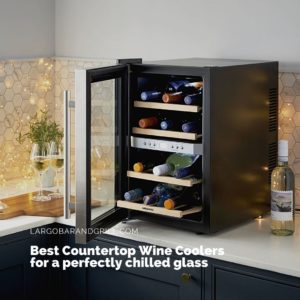Disclaimer: There are affiliate links in this post. At no cost to you, I get commissions for purchases made through links in this post.
Let’s face it – wine is fantastic, but not always easy to understand. This is especially true for knowing how to store and serve wine correctly.
With so many things to take into consideration, like light, heat, humidity, vibration and angle, knowing what to do can feel like an impossible task.
Luckily, with modern-day wine coolers, all the thinking-work is taken away, and you rest easy, knowing your wine is kept in the conditions that will give you the best experience.
But sometimes, knowing what you want in a wine fridge isn’t always straightforward.
That’s why we’ve created this buyers guide to choosing a wine cooler – to ensure you get exactly what you need for your wine collection.
Wine Storage Basics
The first step in buying a wine cooler is knowing precisely what your wine needs to age well. This crucial step allows you to compare coolers easily and make the purchase that best suits you. So, what is it that you should be avoiding and what should you be looking for in a cooler?
Light
One of the worst things your wine can be exposed to is intense exposure to light. Whether it is natural sunlight or artificial light in your home – it should be avoided at all costs. Exposure to light for extended periods of time will significantly affect the aroma and flavor of the wine and almost damper the contents.
So, when looking at a wine cooler, you’ll find that they are generally dark, which protects your valuable wines from any light-damage.
Storing Temperature
Along with avoiding light, you need to be preventing warm temperatures and fluctuating temperatures. That rule about “keeping wine at room temperature” won’t cut it. That rule only really applies for really cold countries – and even then, it isn’t ideal. In order to keep the wine’s quality consistent, you need to keep the temperature at 55°F (12°C) consistently.
Not only will the heat affect the aromas and flavors of the wine, but any fluctuating temperatures can be detrimental too. It sounds like a lot to remember- but wine coolers do all the remembering for you and keep the wine cool and consistent so that you don’t have to worry about it all the time.
Humidity
Humidity is another factor that many people don’t know about, and which is why room-temperature isn’t always ideal. In humid conditions, the cork of the wine bottle is often compromised as it expands and contracts with heat and humidity. This can be detrimental, as an expanding cork allows oxygen to seep into the bottle and cause oxidation. What is worse than an oxidized wine? Knowing that you could have prevented the oxidation by keeping the wine in wine cooler.
Vibration
This may be news to many, but keeping your wine still, with no vibration or movement, is a crucial component to letting the wine age long-term. This is one of the reasons why conventional refrigerators won’t do your wine justice in the long-run since they vibrate quite a bit. Wine coolers are explicitly designed to minimize all vibration and keep your wines perfectly still.
Serving Temperature
Keeping the wine cool for long-term storage is the way to go – but that doesn’t necessarily mean the wine can be enjoyed at these temperatures. For most red wine, serving it between 60 and 65°F (15 – 18°C) is ideal and serving white wine between 50 – 55°F (10 – 12°C) degrees is best. Many wine coolers offer a feature that separates the temperatures and allows you to store certain wines at serving temperatures, while others can be stored long-term.
A great example of a cooler that has separate compartments is the Smith and Hanks 32-bottle Dual-Zone cooler.
3 Things to Look For When Buying a Wine Fridge:
Now that you know exactly what conditions your wine needs to stay at its best, here are a few things to look for in a wine cooler that adds several benefits. Wine coolers aren’t just practical; they can be convenient too.
1. Single Zone vs Dual Zone
When it comes to most wine coolers, there are two general types: single-zone and dual-zone. This is where the storage vs serving temperature factor comes in.
With a single-zone fridge, the temperatures are kept at the same temperature throughout. This is generally best for long-term storage.
There are even options of single-zone coolers than can hold over 100 bottles – making it great for prominent wine collectors.
Dual-zone, on the other hand, has two sections of the fridge where the temperatures can differ from each other. This is great to either separate white and red wines, or to separate long-term storage and wines to drink soon.
The misconception is often than dual-zones are always large fridges, but some are even as small as a 30-bottle fridge – making it ideal for even beginner-collectors.
There is also a multi-zone option, which offers three or four different temperature-areas – which is for those wine-collectors looking to separate their wines into several temperature compartments.
Do you have over 300 bottles that you would like to store at different temperatures? Well, there are even multi-zone options for wine collections of that size!
2. Compressor vs thermoelectric
Another exciting component of a wine fridge is how the coolers create cold air for the wines. These can be considered for those looking for eco-friendly alternatives or those looking for the best long-term cooling options.
Compressor coolers create cool air and then circulate it through the fridge using a fan. Once the ideal temperatures are reached, the compressor switches off and lets the cold air stay in the refrigerator. This is the same system used with conventional fridges. With this system, larger wine-coolers are generally created, but the downside is that they generate some vibration during the cooling process.
Thermoelectric coolers are slightly different. These coolers create cooler air with the use of electric currents – which also sends the air through the fridge with a fan. The difference here is that they are quieter, have less vibration and less expensive than compressor fridges, but cannot be made into large wine-coolers.
3. Freestanding vs being Built-in
The difference between freestanding and built-in coolers are relatively self-explanatory – with each option bringing its own set of benefits.
Freestanding fridges can ideally be plugged into any electric-socket and run wherever you want it. These fridges are ideal for anyone who moves often or wants to relocate the fridge to different parts of a home.
Built-in fridges, however, are specifically designed to fit into smaller spaces under countertops. The benefit of this is that it frees a lot of space and isn’t in the way – but they cannot be moved around easily like with freestanding coolers.
So, whatever your wine cooler needs – there is something on the market just for you. Whether you’re a newbie looking for something small to start with, or whether you have an extensive collection of wines – you can rest assured there is something to suit your every need!
Related Posts
Best Small Wine Cooler – A Comprehensive Review
Disclaimer: There are affiliate links in this post. At no...
Read MoreIs a Wine Fridge Necessary in Your Kitchen?
Disclaimer: There are affiliate links in this post. At no...
Read MoreBest dual zone wine cooler you can buy right now
Disclaimer: There are affiliate links in this post. At no...
Read MoreBest Countertop Wine Coolers for a perfectly chilled glass
Disclaimer: There are affiliate links in this post. At no...
Read MoreWhy Trust Us
You will find what you are looking for at Largo Bar and Grill. From classic to luxury brands, you'll find both. We will help you to select appliances that fit your needs, budget and lifestyle. Whether you want to stop by to learn more — or plan to make a major purchase — we’ll treat you like family and assist you every step of the way. Shop with us today to receive friendly and experienced help along the way.




